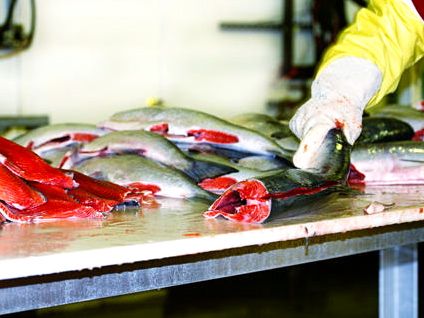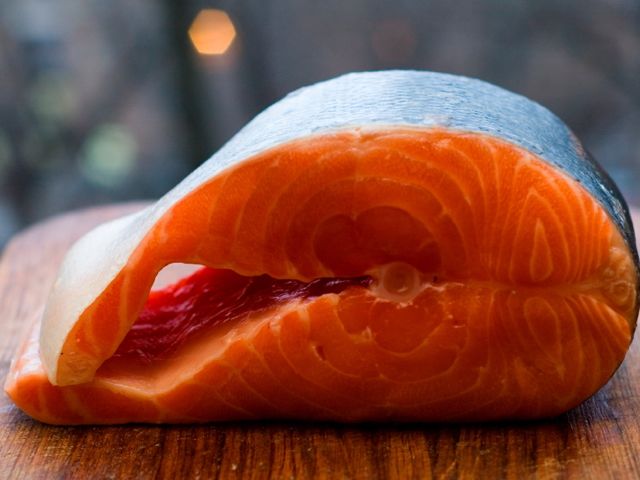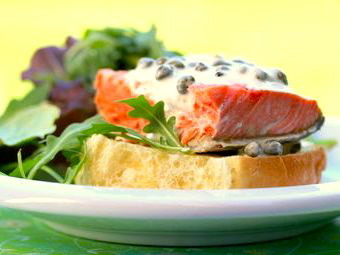
salmonbutcher, l
(article, Cheryl Sternman Rule)
Salmon is tasty, versatile, and healthful — but cooks should choose their salmon wisely. [[block(sidebar). h1.Featured recipes]] First off, opt for wild Alaskan over farmed salmon. Why? Though there may be exceptions, most farmed salmon are raised in pens, where they may be dosed with antibiotics, growth hormones, and colorings. By contrast, wild salmon — such as the sustainably fished Copper River salmon from Alaska — eat a natural marine diet and build substantial fat stores in preparation for their long upstream journey to spawn. More fat means a higher concentration of omega-3s, too. [%image salmonbutcher float=right width=400 caption="Filleting salmon at Copper River Seafood in Cordova, Alaska."] As for which of the salmon species to buy, that’s up to you, as much is available frozen year-round. King (“chinook”) salmon are the largest, with the highest omega-3 fat content and often the dearest price. Sockeye (“red”) is known for its red flesh and firm texture. Coho (“silver”) is delicately flavored, with orange-red flesh. Keta (“chum”) is mild flavored, but lower in omega-3s. And pink salmon, the smallest, is usually sold in cans. Here are eight ways to prepare wild salmon fillets. [[list(culinate8). #(clear n1). Grilled. As a member of the Copper River gill-net fleet, Thea Thomas has been a salmon fisherman in Alaska for 23 years. Though she enjoys salmon every which way, she’s partial to grilling. “I made up this marinade, which I still think is the best," she says. "It's equal parts frozen limeade, olive oil, and soy sauce, with a generous amount of finely chopped garlic and rosemary.” (No limeade? Substitute fresh lime juice and honey to taste.) After a 45-minute soak, she places the fish flesh-side down on the grill to sear, then flips it over and cooks it 10 to 12 minutes longer, or until the salmon slides free of the skin. #(clear n2). Hot smoked. Unlike cold smoking, which produces familiar “bagel-ready” salmon with a smooth mouthfeel (think lox), hot smoking relies on smoldering wood chips to cook the fish all the way through. “I am a hot-smoking kind of chef,” says Trevor White, executive chef at The Oceanaire Seafood Room in Houston, Texas. White marinates wild-salmon fillets in a mixture of brown sugar, kosher salt, bourbon, cola, and black pepper for 48 hours in the fridge. After air-drying the fillets for eight hours (still under refrigeration), he smokes them over applewood chips until firm. “I prefer it at room temperature,” he says, “but it’s also really great cold or hot.” #(clear n3). Cured. [%image reference-image float=right width=300 caption="Seek out wild-caught salmon."] While hot-smoking actually cooks the fish, curing it, in a Scandinavian preparation known as [/recipes/collections/Culinate+Kitchen/Fish+and+Seafood/Gravlax+%28Cured+Salmon%29 gravlax], makes salmon safe to eat without any heat. To cure, pack the salmon with salt, sugar, dill, and peppercorns, place it skin-side down in a dish, then weight it with another dish to force out some of the juices. (See sidebar, above, for a recipe.) Refrigerate from 12 hours up to several days. Rinse, dry, and slice thin, serving with dark bread as a cold first course. #(clear n4). Microwaved. If you use your microwave just for popcorn, you’re missing out, says William S. Gilbert, Jr., the plant manager at Trident Seafoods in Cordova, Alaska, who swears by microwaving salmon. With a microwave, he says, “you can get the salmon to just where it’s done, and you don’t risk overcooking it.” He’s partial to Asian-style marinades, often using a combination of orange juice, ginger, soy sauce, and brown sugar. Cook for three to eight minutes in a microwave-safe dish, depending on the size of the fillets. #(clear n5). Poached. Poaching at a gentle bubble, either on the stovetop or in a 350-degree oven, adds flavor to salmon while keeping it moist. The poaching medium can be a traditional court bouillon, fish stock, or even salted water. Consider serving poached wild salmon with hollandaise sauce, or flaking it into a salad with shallots and vinaigrette. #(clear n6). Broiled. Surely one of the easiest and quickest preparations, broiling salmon produces a crisp top crust, especially if you brush it with your favorite glaze (even apricot preserves will work). Be sure to line your broiler pan with aluminum foil and grease the pan’s rack to prevent the delicate fish from sticking. Broil 6 inches from the heat, until the salmon is just cooked through, for about 10 to 15 minutes, depending on thickness. #(clear n7). Roe. Wild-salmon roe is an affordable caviar alternative, and with its glossy pink hue, it makes a colorful garnish for passed hors d’oeuvres or fish-based entrées. Consider serving it in place of lox alongside small bagels or mini-toasts, with cream cheese, capers, thinly sliced red onion, and fresh lemon wedges. Salmon roe is generally sold in small jars near the fish counter in major supermarkets. #(clear n8). Leftovers. No matter how you cook your salmon initially, slathering it with lemony mayo and capers and shoving it between slices of good bread just may be your favorite preparation of all. [%image sandwich float=right width=300 caption="Cold Salmon Sandwich with Lemon-Caper Mayo"] Try my recipe for a Cold Salmon Sandwich with Lemon-Caper Mayo. ]] p(bio). Cheryl Sternman Rule is a California-based food writer and the voice behind the blog 5 Second Rule. She spent time in Alaska this summer, eating more Copper River salmon than she could count.

salmonbutcher, l

reference-image, l

sandwich, l